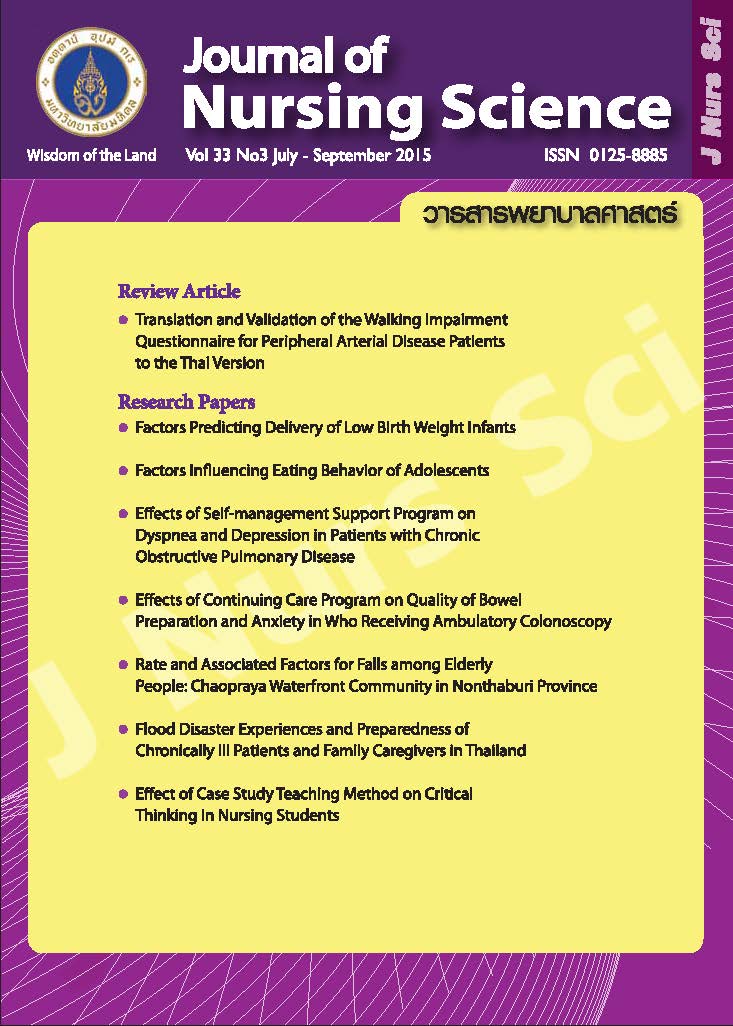Factors Predicting Delivery of Low Birth Weight Infants
Main Article Content
Abstract
Purpose: To determine the predictive power of age, body mass index, weight gain during pregnancy, disease/complications during pregnancy, stress, and social support on low birth weight infants.
Design: Predictive correlational design.
Methods: The subjects were 198 pregnant women with a gestational age of 28-32 weeks at the beginning of the study, who have attended an antenatal clinic and delivery at Siriraj Hospital. Instruments for collecting data included the Personal Data Interview Form, the Perceived Stress Scale, and the Personal Resource Questionnaire. Data were analyzed by percentage, mean, standard deviation, and multiple logistic regression.
Main findings: The findings indicated that age, body mass index, weight gain during pregnancy, disease/complications during pregnancy, stress, and social support could explain 42.8% (Nagelkerke R2 = .428 p < .05) of the variance in low birth weight infants. Body mass index and disease/complications during pregnancy are significant predictors of low birth weight infants.
Conclusion and recommendations: The results suggested that nurses should promote women’s health before they become pregnant by providing knowledge in groups such as in high schools or factories to prevent low birth weight babies.
ปัจจัยทำนายการคลอดทารกแรกเกิดน้ำหนักน้อย
บทคัดย่อ
วัตถุประสงค์: เพื่อศึกษาอำนาจทำนายของอายุ ดัชนีมวลกาย น้ำหนักที่เพิ่มขึ้นขณะตั้งครรภ์ โรคประจำตัว/ภาวะแทรกซ้อนระหว่างตั้งครรภ์ ความเครียด และการสนับสนุนทางสังคม ต่อการคลอดทารกแรกเกิดน้ำหนักน้อย
รูปแบบการวิจัย: ความสัมพันธ์เชิงทำนาย
วิธีการดำเนินการวิจัย: กลุ่มตัวอย่างเป็นสตรีตั้งครรภ์ อายุครรภ์ 28-32 สัปดาห์ เมื่อเริ่มการศึกษาการฝากครรภ์และคลอดที่โรงพยาบาลศิริราช จำนวน 198 ราย เครื่องมือที่ใช้ ประกอบด้วย แบบสัมภาษณ์ ข้อมูลส่วนบุคคล แบบวัดการรับรู้ความเครียด และแบบสอบถามการสนับสนุนทางสังคม วิเคราะห์ข้อมูลโดยใช้ร้อยละ ค่าเฉลี่ย ส่วนเบี่ยงเบนมาตรฐาน และสถิติถดถอยพหุโลจิสติก
ผลการวิจัย: อายุ ดัชนีมวลกาย นํ้าหนักที่เพิ่มขึ้นขณะตั้งครรภ์ โรคประจำตัว/ภาวะแทรกซ้อนระหว่างตั้งครรภ์ ความเครียด และการสนับสนุนทางสังคม ร่วมกันอธิบายความผันแปรของการคลอดทารกแรกเกิดน้ำหนักน้อยได้ร้อยละ 42.8 โดยดัชนีมวลกาย และโรคประจำตัว /ภาวะแทรกซ้อนระหว่างตั้งครรภ์ เป็นปัจจัยที่สามารถทำนายการคลอดทารกแรกเกิดน้ำหนักน้อยได้อย่างมีนัยสำคัญทางสถิติ (p < .05)
สรุปและข้อเสนอแนะ: พยาบาลควรให้ความสำคัญกับการเสริมสุขภาพของสตรีก่อนตั้งครรภ์ โดยการให้ความรู้เป็นกลุ่ม เช่น ในโรงเรียนหรือโรงงาน โดยเฉพาะสตรีตั้งครรภ์ที่มีดัชนีมวลกายต่ำมีโรคประจำตัว /ภาวะแทรกซ้อนระหว่างตั้งครรภ์ เพื่อลดโอกาสในการคลอดทารกแรกเกิดน้ำหนักน้อย
คำสำคัญ: ทารกแรกเกิดน้ำหนักน้อยดัชนีมวลกาย โรคประจำตัว ภาวะแทรกซ้อนระหว่างตั้งครรภ์ ความเครียด
Article Details
Copyright Notice: Nursing Science Journal of Thailand has exclusive rights to publish and distribute the manuscript and all contents therein. Without the journal’s permission, the dissemination of the manuscript in another journal or online, and the reproduction of the manuscript for non-educational purpose are prohibited.

Disclaimer: The opinion expressed and figures provided in this journal, NSJT, are the sole responsibility of the authors. The editorial board bears no responsibility in this regard.

